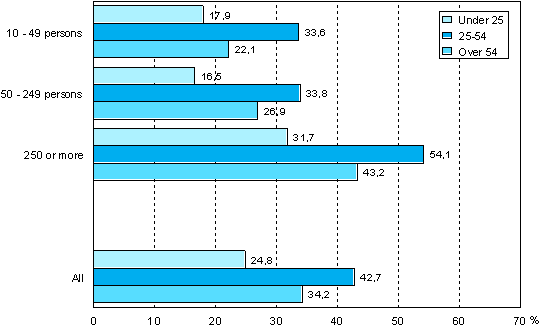5. Participation rate in course training is lowest among young employees
Young employees of enterprises do not receive or seek training in the same way as middle-aged or ageing employees. During 2005, over 40 per cent of employees between the ages of 25 and 54 had participated in course training whereas the respective share among employees under the age of 25 was only 25 per cent.
Figure 9. Participation in course training by age group and size class of enterprise in 2005

The differences in the participation rates by age group were consistent regardless of the size category of the enterprise. In large enterprises, young employees participated in course training nearly twice as frequently as in small enterprises but differences in the participation rates of the age groups were still clear even in large enterprises.
A negative interpretation of the results could come to the conclusion that enterprises’ training policies are discriminatory in respect of the oldest and the youngest age groups. A more positive approach could explain the results with the higher educational level and better readiness of the young people who are entering working life today. For instance, with regard to language or information technology skills the younger age groups are considerably more prepared for the demands of today’s working life than their predecessors. The oldest age group acquired these skills at work or through training provided at the workplace.
Indeed, participation in training is not purely dependent on the supply but also on the employees’ needs and willingness. Adult Education Survey (Adult Education Survey 2006, Statistics Finland) examined the respondents’ personal, work or occupation-related training needs. More than one-half (51%) of the youngest age group (under 25-year-olds) reported a need for continuing vocation training, while the same proportion in the oldest age group (over 54-year-olds) was only 25 per cent. Thus, the youngest age group would appear to have a shortage of training. However, the survey does not provide an answer to whether this means shortage of own activity or of the supply of training.
Enterprises’ own assessments do not shed much more light on the matter either. Enterprises that had provided training were asked about the factors which had influenced the amount of the training they had offered. The adequacy of the personnel’s present competence (present training meets the needs) was especially emphasised by the enterprises in which young employees’ participation rate in course training was low. In contrast, satisfaction with the present level of basic education was highlighted by the enterprises where young employees’ participation rate was high. Precisely the same applied to the oldest age group (aged 55 or over). The results indicate that enterprises do not think of their supply of personnel training expressly from the perspective of equal participation of age groups, either because it is not necessary or because age equality is not regarded as a relevant aspect in the enterprise’s training policy.
Young employees’ participation rate was slightly higher in manufacturing industries than in service industries. However, there were fairly large differences by industry within both sectors.
The results on the participation of different age groups in personnel training are consistently congruent with the data of the 2002 In-service training statistics (In-service training statistics 2002, Statistics Finland). In all age groups, the rate of participation in training has fallen somewhat since 2002, but the differences between the age groups were then much like in 2005 regardless of the size category of enterprise.
Source: CVTS, Continuing vocational training survey, Statistics Finland
Inquiries: Hannu Virtanen 09–1734 2514, Tarja Seppänen 09–1734 3220
Director in charge: Riitta Harala
Updated 8.5.2009
Official Statistics of Finland (OSF):
CVTS, Continuing vocational training [e-publication].
ISSN=1798-0003. Participation in course-format training 2005,
5. Participation rate in course training is lowest among young employees
. Helsinki: Statistics Finland [referred: 8.1.2026].
Access method: http://stat.fi/til/cvts/2005/02/cvts_2005_02_2009-05-08_kat_005_en.html

